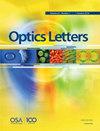自由运行的广域VCSEL造成的混乱。
IF 3.3
2区 物理与天体物理
Q2 OPTICS
引用次数: 0
摘要
我们实验报告了在不需要外部扰动(如光反馈、注入或电流调制)的情况下,从自由运行的商用广域垂直腔面发射激光器(VCSEL)检测混沌的方法。研究了非线性动力学导致混沌行为的演化过程,利用混沌滴定和相关维数表征了系统的复杂性。我们将混沌的发生与空间激光模竞争和偏振动力学之间复杂的相互作用联系起来。本文章由计算机程序翻译,如有差异,请以英文原文为准。
Chaos from a free-running broad-area VCSEL.
We experimentally report on the detection of chaos from a free-running commercial broad-area vertical-cavity surface-emitting laser (VCSEL) without the need for external perturbation such as optical feedback, injection, or current modulation. The evolution of nonlinear dynamics leading to chaotic behavior is studied, and the system's complexity is characterized using chaos titration and correlation dimension. We link the occurrence of chaos with the complex interplay between the spatial laser mode competition and polarization dynamics.
求助全文
通过发布文献求助,成功后即可免费获取论文全文。
去求助
来源期刊

Optics letters
物理-光学
CiteScore
6.60
自引率
8.30%
发文量
2275
审稿时长
1.7 months
期刊介绍:
The Optical Society (OSA) publishes high-quality, peer-reviewed articles in its portfolio of journals, which serve the full breadth of the optics and photonics community.
Optics Letters offers rapid dissemination of new results in all areas of optics with short, original, peer-reviewed communications. Optics Letters covers the latest research in optical science, including optical measurements, optical components and devices, atmospheric optics, biomedical optics, Fourier optics, integrated optics, optical processing, optoelectronics, lasers, nonlinear optics, optical storage and holography, optical coherence, polarization, quantum electronics, ultrafast optical phenomena, photonic crystals, and fiber optics. Criteria used in determining acceptability of contributions include newsworthiness to a substantial part of the optics community and the effect of rapid publication on the research of others. This journal, published twice each month, is where readers look for the latest discoveries in optics.
 求助内容:
求助内容: 应助结果提醒方式:
应助结果提醒方式:


